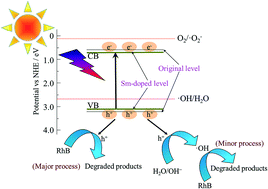Hydrothermal synthesis of Sm-doped Bi2WO6 flower-like microspheres for photocatalytic degradation of rhodamine B
Abstract
In this paper, a series of Sm-doped Bi2WO6 samples with different Sm contents (x Sm-BWO, x = 0.0%, 0.5%, 1.0%, and 2.0%) were successfully synthesized by the hydrothermal method and well characterized by X-ray diffraction (XRD), UV-vis diffuse reflectance spectroscopy (UV-vis DRS), scanning electron microscopy (SEM), photoluminescence (PL) spectroscopy, X-ray photoelectron spectroscopy (XPS), and N2 adsorption–desorption tests. The XRD results indicated that the Sm-doped Bi2WO6 samples exhibited an orthorhombic crystal structure and Sm3+ replacing Bi3+ entered into the Bi2WO6 lattice, producing slight reduction in the average crystallite size. The UV-vis DRS results indicated that Sm3+ doping significantly narrowed the energy band gap. The SEM images show that Sm-doped Bi2WO6 has 3D flower-like microspheres constructed by many loosely connected nanosheets. The photocatalytic activities of the as-prepared samples were evaluated by using rhodamine B (RhB) as the target organic pollutant. It was found that 0.5% Sm–Bi2WO6 has the highest photocatalytic property with a 98.4% removal rate of RhB within 30 min, which was ascribed to the optimum optical absorption activity and the larger specific surface area. It also showed superior stability and reusability after four recycling experiments. Finally, the possible mechanism of photocatalytic degradation was discussed according to the energy band structure and the radical-trapping experiments.



 Please wait while we load your content...
Please wait while we load your content...